10 Perennials for Clay Soil
Clay soil—for many it presents a real challenge in the garden. Though there are lots of ways to improve its texture and drainage, make it easy on yourself and choose to grow plants that naturally thrive in clay soils. Here’s a closer look at ten perennials for clay, shown in order of their bloom times.
Perennial salvia is an absolute delight in the late spring garden. You may be familiar with the vivid purple-flowering types like ‘Violet Riot’, which are easy to spot when they are in full bloom in the landscape. ‘Azure Snow’ produces plump wands of bicolor deep violet blue and white flowers on strong stems above its dense clump of fragrant foliage. You’ll find them all abuzz in spring, as this perennial is a magnet for all sorts of bees, butterflies and hummingbirds. This perennial will tolerate clay soil, but doesn’t like its roots to stay wet for too long. Let the soil dry out a bit between each time you water it rather than keeping it wet all the time. Make sure to plant it in full sun. Salvia likes it hot! See the entire Color Spires series. 18-20” tall, zone 3-9, deer resistant |
You might think this is an astilbe at first glance since it has similar flowers, but this is ‘Chantilly Lace’, commonly known as goatsbeard. It blooms before astilbe in late spring and is much more forgiving if you miss a day of watering. This cultivar is mid-sized with neatly mounded foliage, so it fits best near the middle of the flower border. Tiny pollinating insects enjoy the flowers when in bloom. Goatsbeard grows well in any type of soil, from clay to sand. It doesn’t love a ton of root competition, so planting it right at the base of a tree or ornamental grass wouldn’t be the best place, but normal competition from other perennials is just fine. Part shade is ideal, but this perennial will easily grow and bloom just about anywhere. 30-32” tall, zone 3-7, deer resistant |
This extremely prolific clematis becomes covered in bright blue, nodding bell-shaped flowers in late spring followed by frilly white seed heads in summer. Pollinating bees delight in the pollen-filled blooms. Rather than vining like many clematis, ‘Stand By Me’ is a bush-type, meaning it forms a bushy upright clump like a regular perennial. It does appreciate having some support nearby to lean on, so be sure to surround it with other perennials or small shrubs. You could also use a support like a peony ring to keep it nice and upright. Grow this plant in full sun to part shade in well-drained, alkaline to neutral pH soil. If your clay soil is very dense, amend it with compost or humus to improve the drainage. Clematis likes its roots to stay cool, so spread mulch at its base or shade them by planting other perennials close by. 34-38” tall, zone 3-7, deer resistant |
If you love the look of phlox in your garden, try 'Cloudburst', which blooms after creeping phlox but before tall garden phlox. By planting all three kinds, you can have phlox blooming in your garden from spring to fall. Like many perennials, this one takes a couple of years to really look its best in the garden but will reward you with many years of vivid pinkish purple flowers. The mounded plants become completely covered in fragrant blossoms beginning in early summer, repeating throughout the summer months. Butterflies and hummingbirds enjoy them, too. This variety has excellent resistance to powdery mildew, a fungus that is often found on phlox. Expect its glossy, dark green leaves to stay clean all summer long. Grow this plant in full sun—it is not shade tolerant. It will grow well in your average clay soil, requiring the same amount of water as most of your other perennials like daisies and daylilies. 28” tall, zone 4-8. |
This petite coneflower may be short in stature, but it has huge flower power! Its fragrant blossoms appear in an array of fiery tones from red-orange to pinkish-red from summer into fall. Since it grows just knee high, it’s the perfect perennial to include in your patio pots or along the front of your flower borders. Plant it in a spot where you can watch the bees and butterflies feed on the hot-colored blossoms all season long. Coneflowers need full sun and well-drained soil to grow and overwinter well. They will grow in your clay soil, but you’ll want to amend it with compost or finely shredded bark to improve drainage. Once established, they require less water than average perennials. 12-16” tall, zone 4-8, deer resistant. |
Butterflies and bees delight in this cultivar of our native wildflower which blooms from midsummer to early fall. Perky yellow daisies are perched atop the mounded plants, providing the perfect perch for butterflies to land. Tuscan Gold is a companion to one of our most popular hardy perennials, ‘Tuscan Sun’. Both make excellent cut flowers for your summer bouquets. False sunflowers thrive in the warm summer sun and can tolerate somewhat dry soils once they are established. They won’t mind your clay soil and the clump will increase in size each year. Tuscan Gold: 24-32” tall, zone 4-9. Tuscan Sun: 20-24” tall, zone 3-9. |
Daylilies have long been popular perennials because they are so easy to grow and are more impressive every year as they mature. ‘Orange Smoothie’ has many of the most desirable traits in a daylily: perfect flower form, a sweet fragrance, foliage that remains attractive all season, and reliable rebloom. Ruffled, orange mango blossoms with a rose band sparkle in the midsummer sun. They bloom for several weeks then, and rebloom again later in the season. Grow daylilies in full sun to light shade with average water for best flowering performance. They’ll tolerate almost any soil type, including clay, and multiply from year to year. They can be divided every few years and moved around the garden to add color to all your sunny spaces. See the entire Rainbow Rhythm series. 24” tall, zone 3-9. |
Guaranteed to be one of the most distinctive hosta plants in your collection, this mid-sized variety has heavily rippled foliage. Its powdery blue, thick leaves hold their color well into the summer season, especially when sited in partial to full shade where it is happiest. Morning sun is ideal for this plant. Lavender flowers appear in late summer. Hostas are extremely durable plants in the landscape, surviving all the way down to zone 3. Their main predator is deer, so you may need to provide some protection if they are an issue. Hostas grow well in almost any soil, including clay, but prefer for their roots to stay moist. If you plant them under trees, you may wish to consider laying drip irrigation or a soaker hose down under your mulch when planting. See the entire Shadowland collection. 14” tall x 32” wide, zone 3-9. |
Rose mallow is the star of the late summer garden when its dinner plate-sized blossoms appear abundantly. It is a very large plant, growing the size of a shrub in the landscape, and bears the largest flowers of any hardy perennial. ‘Cherry Choco Latte’ forms a sizeable, bushy clump of dark olive green foliage with bronze highlights. Huge 8-9” flowers begin to pop open in high summer and continue into fall. Their bright white, ruffled petals are accented with extensive red veining and a red eye in the center of each flower. The most important factor in growing rose mallow is water—don’t let these plants dry out. Clay soil tends to hold moisture well and they will happily soak up any extra water you provide. They will also benefit from the nutrients of any compost or humus you mix in. Grow them in full sun for best flowering performance and foliage color. See the entire Summerific collection. 4’ tall, zone 4-9, deer resistant. |
Stonecrop is one of the most durable perennials you’ll find. It thrives in almost any soil, tolerates frigid cold temperatures, and requires little moisture. ‘Popstar’ (shown here) forms a low, wide clump of small, blue-green leaves that are blanketed in bright salmon pink flowers in late summer and fall. ‘Superstar’ forms a petite, dome-shaped clump of blue-gray foliage topped with hot pink flowers in late summer and fall. To achieve the best foliage color, shape and flowering performance, grow these plants in a spot where they can bask in the hot sun all day long. If you live in an area that sees summer rains fairly regularly, no supplemental water will be needed. View the entire Rock ‘N Grow series. 8-12” tall, zone 3-9. |
Patent Info: Color Spires® 'Azure Snow' Salvia USPPAF CanPBRAF; Color Spires® 'Violet Riot' Salvia nemorosa USPP26273, CanPBR5337; 'Chantilly Lace' Aruncus USPPAF CanPBRAF; 'Stand by Me' Clematis USPPAF CanPBRAF; 'Cloudburst' Phlox USPPAF CanPBRAF; Tuscan Gold™ Heliopsis helianthoides USPP29819 CanPBRAF; 'Tuscan Sun' Heliopsis helianthoides USPP18763; Rainbow Rhythm® 'Orange Smoothie' Hemerocallis USPP28643 CanPBRAF; Shadowland® 'Waterslide' Hosta USPPAF CanPBRAF; Summerific® 'Cherry Choco Latte' Hibiscus USPPAF CanPBRAF; Rock 'N Grow® 'Popstar' Sedum USPPAF CanPBRAF; Rock 'N Grow® 'Superstar' Sedum USPPAF CanPBRAF



 Color Spires® ‘Azure Snow’ Perennial Salvia (Salvia)
Color Spires® ‘Azure Snow’ Perennial Salvia (Salvia) ‘Chantilly Lace’ Goatsbeard (Aruncus)
‘Chantilly Lace’ Goatsbeard (Aruncus)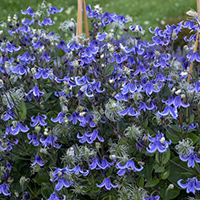 ‘Stand By Me’ Bush Clematis (Clematis)
‘Stand By Me’ Bush Clematis (Clematis)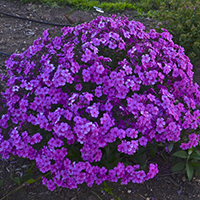 ‘Cloudburst’ Tall Cushion Phlox (Phlox)
‘Cloudburst’ Tall Cushion Phlox (Phlox)  Summersong™ Firefinch™ Coneflower (Echinacea)
Summersong™ Firefinch™ Coneflower (Echinacea)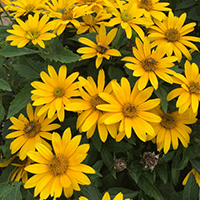 Tuscan Gold™ False Sunflower (Heliopsis)
Tuscan Gold™ False Sunflower (Heliopsis)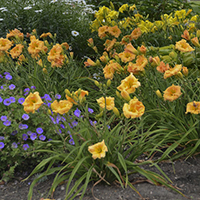 Rainbow Rhythm® ‘Orange Smoothie’ Daylily (Hemerocallis)
Rainbow Rhythm® ‘Orange Smoothie’ Daylily (Hemerocallis)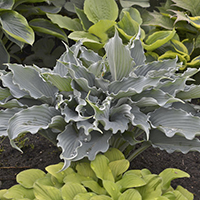 Shadowland® ‘Waterslide’ Hosta (Hosta)
Shadowland® ‘Waterslide’ Hosta (Hosta) Summerific® ‘Cherry Choco Latte’ Rose Mallow (Hibiscus)
Summerific® ‘Cherry Choco Latte’ Rose Mallow (Hibiscus)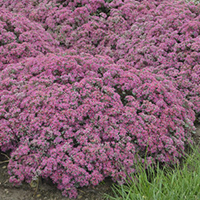 Rock ‘N Grow® ‘Popstar’
Rock ‘N Grow® ‘Popstar’
